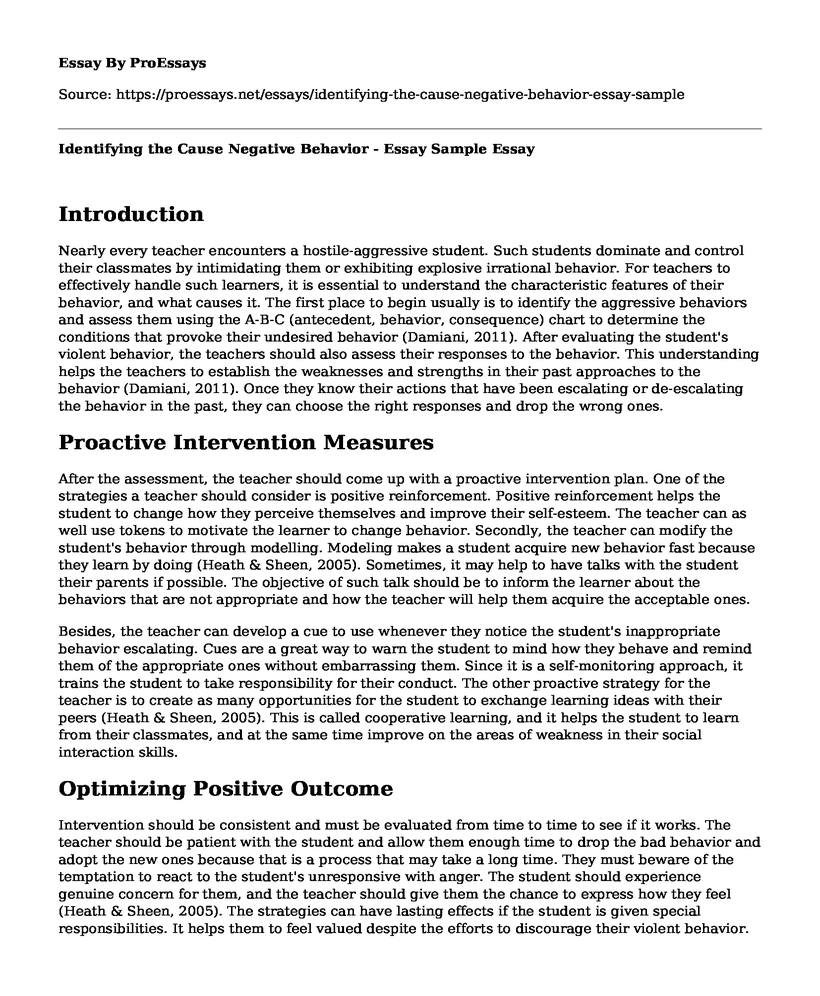Introduction
Nearly every teacher encounters a hostile-aggressive student. Such students dominate and control their classmates by intimidating them or exhibiting explosive irrational behavior. For teachers to effectively handle such learners, it is essential to understand the characteristic features of their behavior, and what causes it. The first place to begin usually is to identify the aggressive behaviors and assess them using the A-B-C (antecedent, behavior, consequence) chart to determine the conditions that provoke their undesired behavior (Damiani, 2011). After evaluating the student's violent behavior, the teachers should also assess their responses to the behavior. This understanding helps the teachers to establish the weaknesses and strengths in their past approaches to the behavior (Damiani, 2011). Once they know their actions that have been escalating or de-escalating the behavior in the past, they can choose the right responses and drop the wrong ones.
Proactive Intervention Measures
After the assessment, the teacher should come up with a proactive intervention plan. One of the strategies a teacher should consider is positive reinforcement. Positive reinforcement helps the student to change how they perceive themselves and improve their self-esteem. The teacher can as well use tokens to motivate the learner to change behavior. Secondly, the teacher can modify the student's behavior through modelling. Modeling makes a student acquire new behavior fast because they learn by doing (Heath & Sheen, 2005). Sometimes, it may help to have talks with the student their parents if possible. The objective of such talk should be to inform the learner about the behaviors that are not appropriate and how the teacher will help them acquire the acceptable ones.
Besides, the teacher can develop a cue to use whenever they notice the student's inappropriate behavior escalating. Cues are a great way to warn the student to mind how they behave and remind them of the appropriate ones without embarrassing them. Since it is a self-monitoring approach, it trains the student to take responsibility for their conduct. The other proactive strategy for the teacher is to create as many opportunities for the student to exchange learning ideas with their peers (Heath & Sheen, 2005). This is called cooperative learning, and it helps the student to learn from their classmates, and at the same time improve on the areas of weakness in their social interaction skills.
Optimizing Positive Outcome
Intervention should be consistent and must be evaluated from time to time to see if it works. The teacher should be patient with the student and allow them enough time to drop the bad behavior and adopt the new ones because that is a process that may take a long time. They must beware of the temptation to react to the student's unresponsive with anger. The student should experience genuine concern for them, and the teacher should give them the chance to express how they feel (Heath & Sheen, 2005). The strategies can have lasting effects if the student is given special responsibilities. It helps them to feel valued despite the efforts to discourage their violent behavior.
Communicating the Plan
Once the teacher has all the proactive behavior change strategies in place, the next challenge is usually communicating them to the student in such a way that they take the corrections positively and not personal. The best way to communicate the plan is normally to call the student alone and begin by assisting them in recognizing their violent behavior before offering to help them (Damiani, 2011). However, if the student responds with arrogance and carelessness, it may be necessary to try this process together with their parents.
References
Damiani, V. B. (2011). Crisis prevention and intervention in the classroom: What teachers should know. R&l Education.
Heath, M. A., & Sheen, D. (2005). School-based crisis intervention: Preparing all personnel to assist. Guilford Press.
Cite this page
Identifying the Cause Negative Behavior - Essay Sample. (2022, Dec 12). Retrieved from https://proessays.net/essays/identifying-the-cause-negative-behavior-essay-sample
If you are the original author of this essay and no longer wish to have it published on the ProEssays website, please click below to request its removal:
- Increasing Safety and Security in Children Environments Essay
- Paper Example on Facial Expression and Emojis in Advertisement and Real Life
- Paper Example on Creativity in the Workplace: A Vital Aspect for Success
- Mental Health Crisis in Universities: Depression & Anxiety on the Rise - Essay Sample
- Unlocking Language Acquisition: The Behaviorist Theory and Its Complements - Essay Sample
- Essay Sample on Workaholism in College: How to Avoid its Lasting Effects
- The Hypothesis of Key Client Issues Essay







